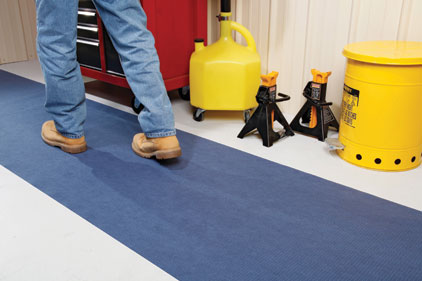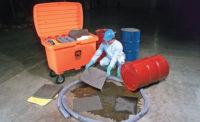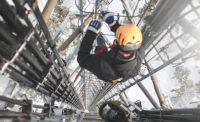Identifying problem areas throughout the facility, qualifying solutions and creating a specific plan to address slip and fall hazards will help promote floor safety and decrease lost work time incidents.
According to a Liberty Mutual study, slips and falls on the same level account for about 65 percent of lost work time injuries each year and have a cost per injury often exceeding $21,000. Most of these injuries are avoidable.
Common causes
Slips and falls to the same level occur when there is a loss of friction between a person’s footwear and the walking surface. Sometimes, multiple factors are at play when a person falls, but the causes can be grouped into three categories: environmental, equipment-related and human error.
Environmental causes include weather-related circumstances, such as rain, snow or ice that covers a walking surface and is not cleared in a timely manner. Poor lighting is another environmental element because it can obscure walking surface hazards that may be more apparent in the daylight or in a brightly lit area.
Worn-out or improperly maintained walking surfaces, uneven pavement and improper footwear choices are examples of equipment-related problems. And, factors such as inattention, haste, fatigue and failure to heed instructions are human factors that can contribute to slip and fall injuries.
Although employees can be taught how to avoid some of the human factors that cause slip and fall incidents, a main focus of most facility floor safety plans is on eliminating or minimizing environmental and equipment problems.
Where incidents happen
Walking surfaces can vary greatly throughout a facility — from highly polished marble foyers to coarse aggregate outdoor storage areas. The characteristics of walking surfaces can also change over time, especially when they are not properly maintained.
Entrances where rain or snow are tracked in; production areas where overspray, leaks and spills are likely; cafeterias and sidewalks are common locations for slip and fall injuries. Walking through and around the facility is one way to find problem areas. Safety or incident reports can also be reviewed to help to identify these and other areas that may be problematic.
In addition to visually inspecting areas, a measurement called Coefficient of Friction (COF) can be used to quantify a surface’s resistance to slipping. A machine called a tribometer is often used to measure COF. This machine simulates the foot’s movement over a surface. The more friction there is between the machine and the walking surface, the higher the COF. Tribometer readings can help a facility determine whether or not various walking surfaces throughout the facility present a hazard.
OSHA does not mandate the use of tribometers, nor do regulations specify what COF a walking surface must have; but in an interpretation letter, OSHA recommends a COF of at least 0.50. The Americans with Disabilities Act (ADA) mandates a 0.60 COF on flat surfaces. Neither, however, specifies the method or instruments to be used to obtain these measurements. The National Floor Safety Institute (NFSI) and ANSI have published a number of standards to provide test methods for measuring the COF on a variety of different surfaces.
Hybrid plans
As plans are developed, gather input from employees and management who work in each area to help determine realistic goals and solutions for each area that has been identified for improvement. Because these individuals are more familiar with the areas, they should have a better feel for what will or will not work. They can also provide information about what has or has not worked in the past. Insurance companies, contract cleaning services, safety footwear and other suppliers are additional sources of information about potential solutions.
Floor safety plans do not need to be elaborate, but often include multiple solutions for each problem area. For example, to prevent slips and falls on an oily floor in a production area, the solution may involve a combination of slip-resistant footwear, absorbent floor matting and signage.
Entrance matting and inclement weather
Traditional entrance mats, especially those commonly supplied by rental services, can be easily overwhelmed during severe weather events. As the mats become saturated, they lose their ability to dry a person’s feet, increasing the chance of a slip and fall when the person walks off of the mat.
Additionally, many entrance mats are too short to completely remove water or snow from shoes as people enter a building. Because few people stop and wipe their feet as they enter a building, entrance mats need to be long enough for a person to take three to five steps before leaving a mat.
Entrance mats with a bi-level construction and edges that dam or trap water and dirt to prevent it from running off of the mat can help minimize slippery areas just beyond the edge of a mat. It is also important to match the mat’s backing to the type of flooring it will cover. Matting manufacturers can help select matting to cover smooth, rough and carpeted surfaces to help prevent mats from sliding, buckling and shifting.
In areas where snow and ice create walking hazards, establish clear protocols for clearing entrances, parking lots and sidewalks. When contractors are used, document times and conditions for snow or ice removal and surface treatment in contracts to help ensure that parking lots and sidewalks are cleared and treated before employees are expected to arrive.
Signage
Temporary signage can be helpful to alert people to a hazard that is not normally present. For example, if a new crack is present in a sidewalk or a spill has recently been cleaned up (but the floor is still wet), cones, barricades and other portable signage devices can be used to help anyone in the area avoid a slip, trip or fall.
Sometimes, despite your best efforts, certain areas of a facility may always have wet or slippery floors. Permanent signage can be used at entrances, near aisles and throughout these areas to help reinforce the need to take additional precautions.
Spill cleanup
Fluid transfer and waste collection areas are common locations for leaks and small spills. Production lines and loading docks are additional areas where spills are either routine or somewhat predictable. Even cafeterias and break rooms host the occasional mishap when food or beverage spills aren’t promptly cleaned up.
Stocking appropriate spill response supplies in spill-prone areas facilitates fast response and helps prevent the leak or spill from causing a slip and fall incident. A supply of paper towels or wipes and a waste receptacle may be all that are needed to encourage quick cleanups for tiny leaks and drips. Spill response kits containing absorbent mats and socks, squeegees, brooms or other equipment are handy in areas where larger spills could occur — like loading docks and transfer areas.
Employees should be taught where spill response materials are kept, how to use those items, as well as what to do with spent materials after a spill has been cleaned up. For employees who may not regularly come in contact with spills and are not trained, signage could be used to remind them who to call so that the spill can be handled quickly and safely.
Floor cleaning supplies
Sometimes, a floor that should have an adequate COF to prevent slips and falls is compromised by improper cleaning. Using the wrong type or the wrong amount of a cleaning chemical can pre-maturely damage the surface, or could leave residues that make the floor slippery.
Following manufacturer’s directions for both the amount of cleaner to be used and the frequency of cleaning will help floors maintain a higher level of traction for a longer period of time. A variety of non-slip paints and other types of finishes are available to help increase the COF of nearly any walking surface that is already worn or damaged.
Footwear
Wearing the wrong type of slip-resistant footwear can be as dangerous as wearing a pair of bedroom slippers on an ice skating rink – especially if they lure the person wearing them into a false sense of safety. When slip-resistant footwear is being considered as part of a floor safety program, it is important to match that footwear to the specific type of slip hazard that is present in the facility.
Footwear that is designed for slip resistance in kitchens and restaurants often fails in an industrial setting because the fluids that are making the floor slippery are different from those found in food services. This can lead to the shoes slipping because the tread pattern is wrong for the type of liquid, or to the soles degrading because they are not chemically resistant to the fluids on the floor.
Production line workers are not the only ones who may need slip-resistant footwear. Consider proper footwear for managers, office staff, visitors and others who could enter areas that are known to be slippery. Several safety footwear suppliers offer slip-resistant overshoes for those who may only need this non-slip footwear occasionally.
Having a plan in place to periodically evaluate and replace footwear is also an important planning element. Like any other type of safety equipment, footwear doesn’t last forever, and a shoe that has been worn too long does not help to encourage safety. Footwear manufacturers can help gauge an expected lifespan based on facility conditions. Typical lifespans can range from six weeks to six months.
Your floor safety plan
Creating a floor safety plan that incorporates these elements will help minimize or eliminate slip and fall hazards throughout the facility. Improving floor conditions and providing employees with the tools and equipment to identify and clean up hazards quickly will help improve both productivity and safety.


